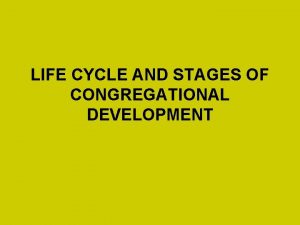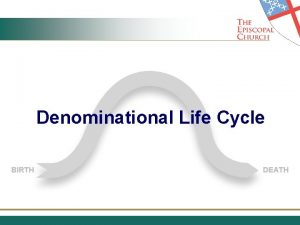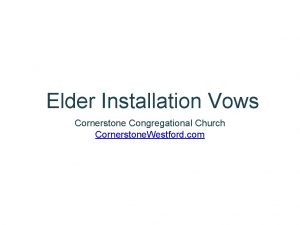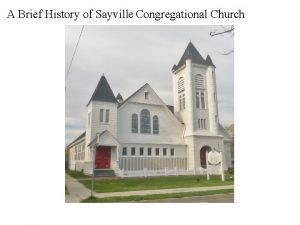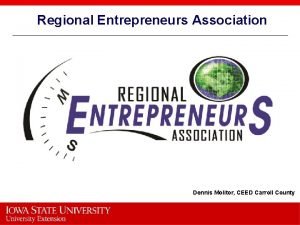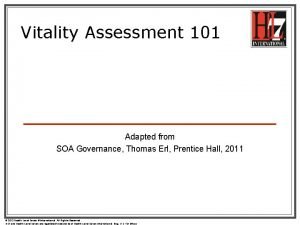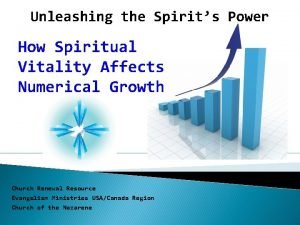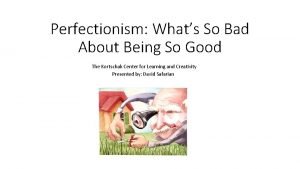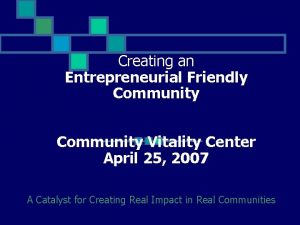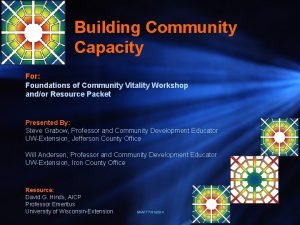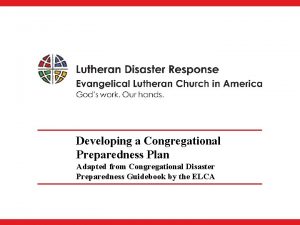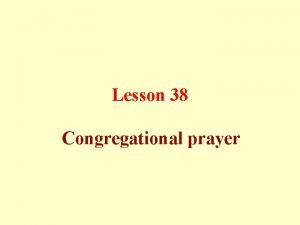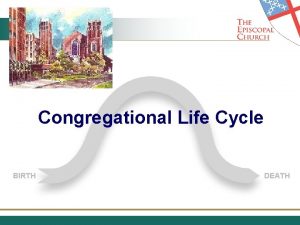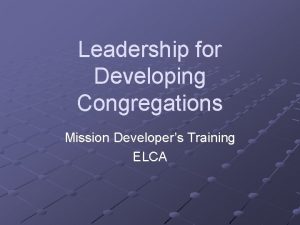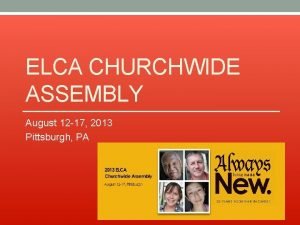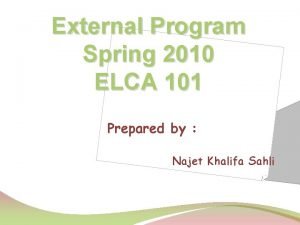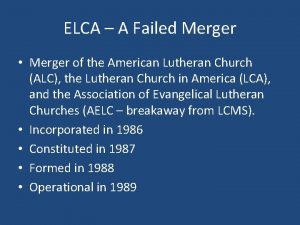Congregational Vitality Project Congregational Vitality in the ELCA


























- Slides: 26

Congregational Vitality Project Congregational Vitality in the ELCA Presented to: Religious Research Association – 2016 Atlanta DEM Gathering – 2016 in Chicago Linda Bobbitt Evangelical Lutheran Church in America

What is a vital congregation? • Fulfilling mission Great Commandment, Great Commission – Connecting with God, each other and the world – • Sustaining mission over time – • Critical mass of people, energy and financial resources We need to change the conversation about what it means to be a vital church.

Congregational Vitality Project Goals 1. Learn to measure congregation’s mission 2. Measure current vitality and identify priorities for ELCA, synods and congregations 3. Learn how to help congregations become more vital. 4. Replicate best practices across the church. 5. Ultimate goal to increase the number of vital congregations in the ELCA.

Measuring mission • Vitality Surveys Every member survey – long form (over 400 surveys since 2012, >25 K individuals) – Congregational Leadership – short form (93 congregations) – Key Informant – annual report for ELCA (7069 congregations) – www. Congregational. Vitality. Project. com

ELCA Report & Synod Reports available at www. congregationalvitalityproject. com

Annual Report • 7069 Congregations answered vitality questions on annual report – 75% reporting • Key informant – usually pastor, sometimes secretary or group response • 15 Item CVS Scale Reliability r=. 913, all one factor

Do key informants represent larger congregation? 184 congregations took larger member surveys in 2015 -2016& annual report – Correlated r=. 617 – Paired t test: On average, key informants rated congregations lower – • – (3. 7 vs 3. 8) (t=-4. 527 (183) p=. 000) Chart shows difference (Congregations – Key Informants

Vitality in the ELCA All ELCA congregations percent by level Scale 1 (poor), 3 (okay), 5 (very well) Average 15 items Very well; 11. 0% Struggling; 8. 5% Vitality levels Very well= >4. 5 Well= 4 -4. 4 Well; 26. 7% Okay= 3 -3. 9 Struggling=<3 Okay; 53. 7%

Areas of Strength and Challenge

Specific items

Vitality by stage of development • SAWC: Synodically Authorized Worshiping Communities – Exploratory • CUD: Congregations Under Development • Newly Organized: last 3 years • Established

New ministry strategies- forming congregations

Myth Busting Investigating some of the myths about what it means to be missional

Larger Congregations are more vital Average Worship 1 - Small 2 -Pastoral 3 - Program 4 -Corporate 5 -Mega Average Vitality by size 5 4 3. 5 3 ANOVA • • Significant differences – low/high Adjacent the same 2. 5 2 1. 5 1 Small Pastoral Program Corporate Mega

Size and Vitality – Deeper look But… vital congregations aren’t necessarily large 400 350 Number of Cong. 300 250 200 150 100 50 0 Least Vital (<3) Small Pastoral Most Vital (>4. 5) Program Corporate Mega

Rural congregations are less vital than those in suburbs Context 1 - Rural farm 2 -Rural non farm 3 - Small city <10 K 4 -Small city 10 -60 K 5 -Med. City 60 -250 K 6 -Suburb near med city 7 - Large city >250 K 8 -Suburb <10 miles of large 9 - Suburb > 10 miles of large • Chi-square is significant But differences minimal

Context and Vitality – Deeper look Many rural cong. struggle, but many are also vital 180 160 Number of Cong. 140 120 100 80 60 40 20 0 Least Vital (<3) Most Vital (>4. 5) Rural farm Rural non farm Small city <10 k Small city 10 -60 K Med city Suburb near med city Large city Suburb <10 miles Suburb >10 miles

Vital congregations are more generous. • Types of generosity – – – Regular giving - members giving unrestricted dollars to congregation Mission Support – given to denomination Other – given to local and national causes • Controlled for size (ANOVA comparisons) • Regular giving per attendance: No – vital congregations are not more generous – Giving changes f 0 r good and bad reasons • • Mission support – • Very high per member giving in small and pastoral churches with low vitality Very low per member giving in corporate congregations with low vitality Per member giving tends to be higher in smaller congregations No difference between more and less vital cong. Other giving – – No difference in smaller cong. Corporate and mega cong. gave more when vitality >4 • Corporate 4. 8%-6. 5%, Mega 4%-8. 5%

Congregations that are more sustainable are more generous Balanced budget = income within 10% of expenses or more (ANOVA comparisons) • Regular Giving – • Congregations that balanced their budget (income=> expenses) had higher per member giving Mission support – Small, pastoral and program cong. with balanced or positive budgets gave slightly higher percentage to mission support • • small 3. 5%-4. 3%, pastoral 3. 6% -4. 6%, program 3. 9%-5% Other giving is related to whether a congregation lost or earned money last year. – Pastoral and program cong. with balanced+ budgets gave a more • pastoral 3. 5%-4%, program 3. 7%-4. 9%

Congregations that emphasize tithing are more generous • Congregations that emphasize tithing tend to be larger • When size is controlled: Vitality is higher in small, pastoral and program churches that emphasize tithing – Per member giving is higher in small and pastoral churches that emphasize tithing – (t- test comparing those who emphasize tithing with those that don’t)

Sustainability & Vitality Can we remain vital into the future?

Outlook toward the future (all congregations) 5 4. 12 4 3. 3 3. 53 3. 63 3. 8 2. 95 2. 5 2 1. 5 1 Not sure we will survive Struggling now, should Doing okay now, future Struggling now, future Doing okay now, should much longer continue uncertain looks better continue Thriving

Future Outlook– all congregations 60. 0% 50. 0% 40. 0% 30. 0% 20. 0% 10. 0% Least Vital Most Vital May not survive much longer Struggling now, should continue Doing okay no, future uncertain Struggling now, future looks better Doing okay now, should continue Thriving

Growth comparisons • • Matched sample of 473 congregations from around the church. Compared each vitality level to the change in worship attendance from 2010 -2015 Vitality & Growth CVS score by change in worship attendance 2010 -2015 60 50 40 30 20 10 0 -10 -20 Struggling Doing okay Doing well Average change in worship attendance Doing very well

Mission & Sustainability New. Organized Cong. Newly Not Currently Established Cong Not Currently Sustainability levels – 2015 data SAWC/CUD (not Cong sustainable (not Stable or or increase including grants) • Not Sustainable= income> -10% of expenses including grants) • Sustainable income within 10% of expenses or >10% Vitality levels • Not Vital = CVS ave <4 • Vital. Not = CVS Vitalave >4 Not Vital 9% 29% 47% 29% 40% 22% 15% 20% 24% 48% 11% 7%

Implications • Needs – – • New congregations focus on sustainability. Established congregations focus on renewal of mission. This is the greatest need in the ELCA. Current research focused on measuring congregational renewal efforts. Connecting missional congregation theory to congregational renewal efforts and testing to see what happens. – 12 participating synods – Quantitative and qualitative data collection (pre-post) systematic outcomes Increased vitality scores • Changes in mission support, attendance • Establishment of new practices (spiritual, adaptive, neighborhood relationships) • Shift in missional imagination • www. Congregational. Vitality. Project. com
 Congregational life cycle
Congregational life cycle Congregational life cycle
Congregational life cycle Congregational confession this is my bible
Congregational confession this is my bible Cornerstone congregational church
Cornerstone congregational church Sayville congregational church
Sayville congregational church Vitality runners
Vitality runners Vitality
Vitality Humana vitality
Humana vitality Generali wellness
Generali wellness Eudemonistic model of health
Eudemonistic model of health Subjective perception of vitality and feeling well
Subjective perception of vitality and feeling well Signs of vitality
Signs of vitality Dennis molitor
Dennis molitor Ethnolinguistic vitality
Ethnolinguistic vitality 10 signs of vitality
10 signs of vitality Vitality globules
Vitality globules Broadcom vitality program
Broadcom vitality program Vitality soa
Vitality soa Spiritual vitality
Spiritual vitality Vitality unsecured
Vitality unsecured Community vitality
Community vitality Vitality
Vitality Irreversible pulpitis vs reversible pulpitis
Irreversible pulpitis vs reversible pulpitis Vitality adj
Vitality adj Community vitality definition
Community vitality definition Hát kết hợp bộ gõ cơ thể
Hát kết hợp bộ gõ cơ thể Ng-html
Ng-html
